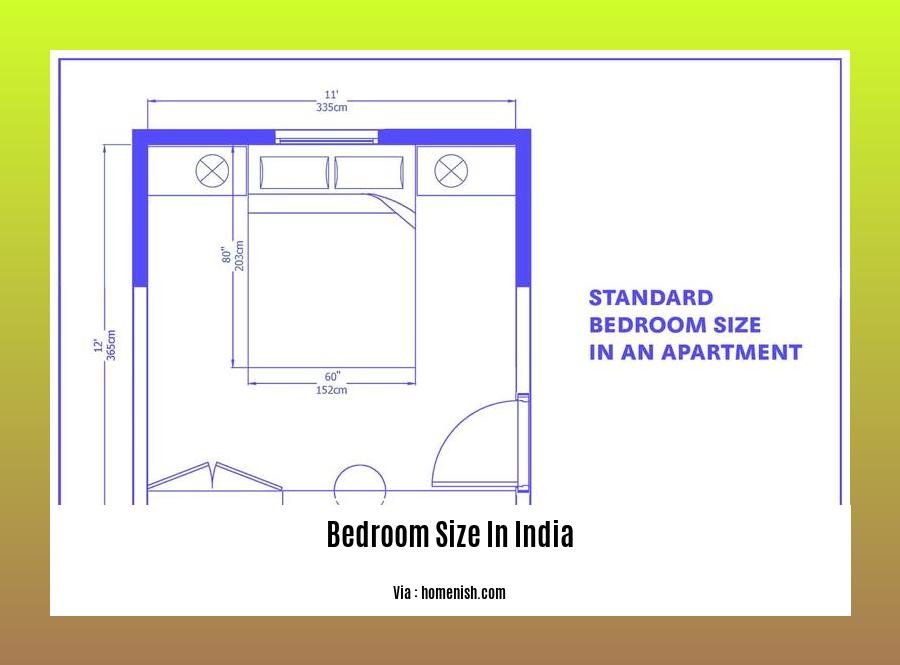Are you in the market for a new home in India? Wondering about the ideal bedroom size? Look no further! Dive into our comprehensive guide, [Exploring Bedroom Size in India: A Comprehensive Guide for Homebuyers and Investors]. Understand the factors influencing bedroom size, from cultural preferences to market trends. Discover how bedroom size impacts functionality, comfort, and investment potential. Whether you’re a first-time homebuyer or a seasoned investor, this guide will provide valuable insights into making informed decisions about bedroom size in India.
Key Takeaways:
-
Building codes in India mandate a minimum of 70 sq ft for single-occupant bedrooms and 120 sq ft for double bedrooms.
-
Standard bedroom sizes commonly range from 10ft X 12ft to 14ft X 16ft.
-
The minimum occupancy rate is 13.3 persons per 100 sq.m.
-
Careful space planning is crucial for smaller bedrooms to create the illusion of a larger area.
Bedroom Size in India: A Comprehensive Guide for Homebuyers and Investors

Understanding bedroom size in India is crucial for homebuyers and investors seeking a comfortable and functional living space. This guide explores the various factors influencing bedroom size, from building codes to standard dimensions, to help you make informed decisions.
Factors Influencing Bedroom Size in India
-
Building Codes: Indian building codes set minimum bedroom size requirements based on occupancy. For single-occupancy bedrooms, the minimum size is 70 square feet, with one dimension not less than 7 feet. For double bedrooms, the minimum size is 120 square feet.
-
Standard Dimensions: Standard bedroom size dimensions typically range from 10 feet by 12 feet to 14 feet by 16 feet. These dimensions offer a comfortable space for furniture arrangement and movement.
-
Occupancy Rate: The minimum occupancy rate in India is 13.3 persons per 100 square meters. This rate determines the maximum number of people who can occupy a given space, including bedrooms.
-
Space Optimization: Smaller bedrooms require careful planning to optimize space and create the illusion of a larger area. This can be achieved through clever furniture placement, strategic storage solutions, and the use of mirrors to reflect light and create depth.
Implications for Homebuyers and Investors
-
Homebuyers: When purchasing a property, homebuyers should consider the bedroom size in relation to their needs and preferences. Factors such as the number of occupants, furniture requirements, and personal preferences should be taken into account.
-
Investors: For investors, bedroom size can impact rental income and property value. Larger bedrooms tend to command higher rents and attract a wider pool of tenants. Additionally, properties with well-sized bedrooms are more likely to appreciate in value over time.
Additional Considerations
-
Regional Variations: Bedroom size may vary across different regions in India due to factors such as cultural preferences, building regulations, and land availability. It is essential to research the local market to understand the typical bedroom size in the area.
-
Personal Preferences: Ultimately, bedroom size is a matter of personal preference. Some individuals may prefer larger bedrooms for spaciousness and comfort, while others may prioritize smaller bedrooms to save on space and cost.
By considering the factors influencing bedroom size in India, homebuyers and investors can make informed decisions that align with their needs, preferences, and investment goals.
-
Looking to furnish your bedroom with railway furniture? Check out new railway furniture catalog.
bedroom railway furniture catalogue -
Are you seeking a larger tiny home? Explore our collection of spacious homes available for purchase.
larger tiny homes for sale -
Curious about standard master bedroom sizes in India? Learn more about recommended dimensions.
master bedroom size in india
Implications of Bedroom Size for Homebuyers
Bedroom size is a crucial consideration for homebuyers, as it directly impacts comfort, functionality, and overall satisfaction with a property. Several factors come into play when determining the ideal bedroom size, including the number of occupants, furniture requirements, personal preferences, and resale value.
Factors to Consider
- Number of Occupants:
- Consider the number of people who will be using the bedroom regularly.
-
A single occupant may find a smaller bedroom adequate, while a couple or family with children will require a larger space.
-
Furniture Requirements:
- Assess the furniture items you need in the bedroom, such as a bed, wardrobe, dresser, and study table.
-
Ensure the bedroom size can accommodate all essential furniture without overcrowding.
-
Personal Preferences:
- Consider your personal preferences for space and comfort.
-
Some individuals prefer larger bedrooms with ample room for movement, while others may be comfortable in a cozier space.
-
Resale Value:
- If you plan to sell the property in the future, consider the resale value impact of the bedroom size.
- Larger bedrooms tend to command higher prices and attract a wider pool of potential buyers.
Implications for Homebuyers
- Smaller Bedrooms:
- Smaller bedrooms can be suitable for individuals or couples who prioritize affordability and prefer a cozy ambiance.
- They may also be suitable for guest rooms or children’s bedrooms.
-
However, smaller bedrooms may feel cramped if used by multiple occupants or if they need to accommodate a lot of furniture.
-
Larger Bedrooms:
- Larger bedrooms offer more space for movement, furniture, and personal belongings.
- They provide a sense of luxury and comfort and can be ideal for families, couples, or individuals who value spaciousness.
- Larger bedrooms also tend to have a higher resale value.
Key Takeaways:
-
Bedroom size is a crucial consideration for homebuyers, impacting comfort, functionality, and resale value.
-
Factors to consider: number of occupants, furniture requirements, personal preferences, and resale value.
-
Smaller bedrooms: suitable for individuals or couples prioritizing affordability and coziness; may feel cramped if used by multiple occupants or need to accommodate a lot of furniture.
-
Larger bedrooms: offer more space for movement, furniture, and personal belongings; provide a sense of luxury and comfort; ideal for families, couples, or individuals who value spaciousness; tend to have a higher resale value.
-
Carefully evaluate your needs, requirements, and long-term plans when selecting a bedroom size to ensure it aligns with your lifestyle and financial goals.
-
Consult with real estate professionals or interior designers for guidance on optimizing bedroom space and maximizing its functionality.
Citations:
Bedroom Size Dimensions
Designing Idea
Impact of Bedroom Size on Property Prices

When searching for a new home or making investment decisions in India, bedroom size plays a crucial role in determining property prices. Not only does it impact the livability and comfort of a residence, but it also significantly influences its market value. Let’s delve deeper into the factors that contribute to the impact of bedroom size on property prices in India.
Factors Impacting Property Prices
-
Location: Location remains a primary factor influencing property prices. Homes in desirable areas with proximity to amenities such as schools, hospitals, and transportation hubs tend to command higher prices.
-
Demand and Supply: The balance between demand and supply directly affects property prices. High demand for properties in a particular area, coupled with limited supply, can lead to increased prices. Conversely, oversupply can result in lower prices.
-
Economic Conditions: The overall economic climate, including interest rates, inflation, and economic growth, also impacts property prices. A strong economy with low-interest rates often boosts demand for properties, driving up prices.
Impact of Bedroom Size
-
Space and Comfort: Bedroom size directly influences the overall space and comfort of a home. Larger bedrooms offer more space for furniture, movement, and storage, making them more desirable to buyers.
-
Resale Value: Properties with larger bedrooms tend to have higher resale value. This is because buyers are willing to pay a premium for homes that offer more space and comfort.
-
Rental Income: For investors, larger bedrooms can translate to higher rental income. Tenants are often willing to pay more for properties with spacious bedrooms.
-
Occupancy Rate: India’s building codes set minimum occupancy rates for bedrooms, which can impact property prices. Higher occupancy rates may necessitate larger bedrooms, leading to increased construction costs and, consequently, higher property prices.
-
Personal Preferences: Ultimately, bedroom size is influenced by personal preferences. Some buyers may prioritize larger bedrooms for comfort and luxury, while others may be willing to sacrifice size for affordability.
Key Takeaways:
-
Location: Desirable locations command higher prices, regardless of bedroom size.
-
Demand and Supply: High demand and limited supply can drive up prices, making bedroom size a crucial factor.
-
Economic Conditions: A strong economy and low-interest rates positively impact property prices, including those with larger bedrooms.
-
Space and Comfort: Larger bedrooms offer more space for furniture, movement, and storage, increasing their desirability.
-
Resale Value: Properties with larger bedrooms tend to have higher resale value, attracting buyers willing to pay a premium for space and comfort.
-
Rental Income: Investors can earn higher rental income from properties with larger bedrooms, as tenants are willing to pay more for spacious accommodations.
-
Building Codes: Minimum occupancy rates set by building codes influence bedroom size, impacting construction costs and, ultimately, property prices.
-
Personal Preferences: Bedroom size is ultimately a matter of personal preference, with some buyers prioritizing space and others focusing on affordability.
Sources:
Future Trends and Emerging Preferences in Bedroom Size
Homebuyers, investors, and homeowners are exploring new trends and emerging preferences in bedroom size to match evolving lifestyles and spaces. Whether it’s maximizing comfort, creating versatile spaces, or meeting specific design needs, there’s a shift in how bedrooms are being planned and utilized, in tune with modern living.
Factors Shaping Bedroom Size Preferences:
-
Changing Family Structures: Smaller households and the growing number of single-occupant homes influence the demand for smaller bedrooms that optimize space.
-
Multifunctional Spaces: Bedrooms are no longer just for sleeping; they’re morphing into multi-use areas for work, entertainment, and personal wellness.
-
Sustainability and Efficiency: Smaller bedrooms promote sustainability by reducing energy consumption and encouraging efficient space planning.
-
Aging Population: Designing bedrooms with accessibility and safety features for the aging population requires space modifications.
Design Considerations:
-
Flexible layouts: Adaptable spaces allow bedrooms to transform based on need, such as adding a workspace or accommodating guests.
-
Built-in storage: Maximizing storage solutions within the bedroom’s footprint keeps the space clutter-free and organized.
-
Multifunctional furniture: Incorporating furniture pieces that serve multiple functions, like a bed with built-in storage or a desk that converts into a nightstand, saves space and adds functionality.
-
Natural light and ventilation: Ensuring adequate natural light and proper ventilation creates a healthier and more inviting space.
Trends in Bedroom Size:
-
Compact Bedrooms: Smaller bedrooms, ranging from 100 to 120 square feet, are becoming increasingly popular, especially in urban areas where space is a premium.
-
Multifunctional Master Suites: Master bedrooms are expanding to include dedicated spaces for work, relaxation, and even fitness areas.
-
Guest Rooms and Flex Spaces: Flexible guest rooms and multifunctional spaces that can convert into bedrooms when needed are gaining traction.
Key Takeaways:
-
Adaptability: Bedrooms are moving towards flexible layouts that accommodate changing needs and preferences.
-
Multifunctionality: The lines between work, rest, and play are blurring, leading to bedrooms that serve multiple purposes.
-
Space Optimization: Efficient use of space, clever storage solutions, and multifunctional furniture are key to maximizing smaller bedrooms.
-
Wellness and Comfort: Incorporating elements of wellness and comfort, such as natural light, proper ventilation, and ergonomic furniture, is essential for creating a restful retreat.
-
Personalization: Bedrooms are becoming more personalized, reflecting individual tastes and preferences, from color schemes to décor choices.
Sources:
- Bedroom Design Trends 2023: 5 Key Trends to Watch Out For
- Bedroom Trends 2023: Everything You Need to Know
FAQ
Q1: What is the minimum bedroom size according to building codes in India?
A1: The minimum bedroom size for a single-occupant is 70 sq ft, with one dimension not less than 7 feet. For a double bedroom, the minimum size is 120 sq ft.
Q2: What are standard bedroom sizes in India?
A2: Standard bedroom sizes typically range from 10ft X 12ft to 14ft X 16ft. For children or young adults, standard bedroom sizes range from 10 feet x 10 feet to 12 feet x 12 feet.
Q3: How can I make the most of a small bedroom?
A3: Careful planning is essential for smaller bedrooms. Select furniture that is proportionate to the room’s size and consider using multifunctional pieces. Strategically place mirrors to create the illusion of a larger space and incorporate clever storage solutions to keep the room organized and clutter-free.
Q4: What factors influence the size of bedrooms in India?
A4: Several factors influence bedroom size in India, including building codes, cultural preferences, and affordability. Building codes set minimum size requirements, while cultural preferences and affordability play a role in determining the actual size of bedrooms. In urban areas, space constraints and high land costs often lead to smaller bedrooms compared to suburban or rural areas.
Q5: How does bedroom size impact the value of a property in India?
A5: Bedroom size is a crucial factor in determining a property’s value in India. Larger bedrooms, especially in master suites, are generally associated with luxury and comfort, making them more desirable to buyers. In markets where space is limited, such as urban areas, a property with larger bedrooms can command a premium price compared to similar properties with smaller bedrooms.
- The Best Battery Picture Lamps for Effortless Artwork Illumination - April 1, 2025
- Double Sink Bath Vanity Tops: A Buyer’s Guide - April 1, 2025
- Bath Towel Measurements: A Complete Guide to Choosing the Right Size - April 1, 2025










